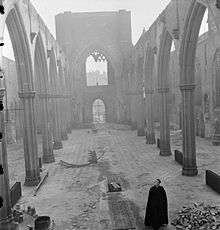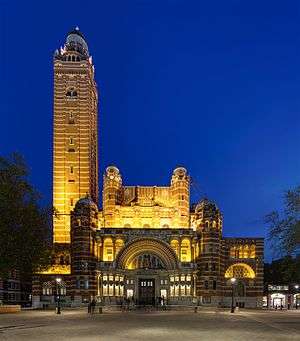St George's Cathedral, Southwark
| St George's Cathedral, Southwark | |
|---|---|
| Metropolitan Cathedral Church of St George | |
 | |
 St George's Cathedral, Southwark Shown within Central London | |
| Coordinates: 51°29′52″N 0°06′28″W / 51.4978°N 0.1079°W | |
| Location | Southwark, Greater London |
| Country | England |
| Denomination | Roman Catholic |
| Website |
www |
| History | |
| Status | Cathedral |
| Consecrated | 1848 |
| Architecture | |
| Functional status | Active |
| Architect(s) | Augustus Welby Northmore Pugin |
| Style | Gothic Revival |
| Administration | |
| Archdiocese | Southwark |
| Province | Southwark |
| Clergy | |
| Archbishop | Most Rev. Peter Smith |
| Dean | Canon Richard Hearn |
| Laity | |
| Director of music |
Previous: Nick Gale Current: Norman Harper |
| Organist(s) | Frederick Stocken |
The Metropolitan Cathedral Church of St George, usually known as St George's Cathedral, Southwark is the cathedral of the Roman Catholic Archdiocese of Southwark, south London and is the seat of the Archbishop of Southwark.
The Cathedral is the Mother Church of the Roman Catholic Province of Southwark which covers the Archdiocese of Southwark (all of London south of the River Thames including Kent and north Surrey) and the Dioceses of Arundel and Brighton, Portsmouth, and Plymouth. It is the Metropolitan Cathedral of the Archbishop of Southwark.
The Cathedral is situated opposite the Imperial War Museum on Lambeth Road in London (on the corner with St George's Road). In Westminster Bridge Road, close by to the north, is St George's Cathedral Roman Catholic Primary School and the headquarters of CAFOD.
History

St George's was built in 1848. Previously, the local Catholic community had used a small chapel on London Road, but the arrival of Irish immigrants in the area necessitated the construction of a larger house of worship.[1] In 1852, it became one of the first four Catholic churches in England and Wales (and the first in London) raised to cathedral status since the English Reformation.[2] It was designed by Augustus Pugin, famous for his work with Charles Barry on the design of the rebuilt Houses of Parliament. Pugin was the first person to be married in the church on 10 August 1848 to his third wife Jane. The Cathedral was badly bombed during World War II and the rebuilt Cathedral was opened in 1958. Since then it has resumed its role as a focal point in the local community and has played host to many notable visitors, including the Dalai Lama (1998) and Pope John Paul II (1982), the latter being depicted in one of the Cathedral's many fine stained-glass windows.
Easter 2011 saw the partial restoration of the 1958 John Compton organ and the installation in the chancel of the George Pace Choir Stalls, a gift from the Anglican St Alban's Cathedral. The Cathedral has strong links with both the Paderborn Cathedral, North-Rhine-Westphalia, which suffered bombing by the British in the Second World War, and Southwark Cathedral, the local Anglican cathedral.
Choirs and music
The Cathedral Choir have constantly performed at various events since 1848, and their performances have been broadcast on BBC Radio and TV, such as Christmas Midnight Mass in 2015 on BBC1.[3]
Today
The cathedral is a working church for the community. For example, the Latin American community is served with a Spanish Mass every Sunday at 1 pm, celebrated entirely in the Spanish language. Every Mass is attended by people of different ethnicities and ages, ranging from African to Asian to European. The Latin Mass Society of England and Wales have made several visits to the cathedral to celebrate both Low Mass and Solemn High Mass in the usus antiquior (older use) that Pope Benedict XVI's motu proprio Summorum Pontificum (2007) authorised as an extraordinary form of the Roman Rite (the 1962 version of the Tridentine Mass).
The cathedral is located on a historic site close to the Imperial War Museum, and a few minutes' walk from London's South Bank and the Thames, Westminster Bridge, the London Eye, and landmarks such as St Thomas' Hospital and Waterloo station. Each summer it is used by London South Bank University for its graduation ceremonies. It is also frequently used for the Convocations of the Academy of Saint Cecilia. The acoustics attract many orchestras and choirs to perform concerts in the Nave and the Whitehall Orchestra and Trinity College of Music are frequent visitors.
 A view of the George Pace Choir Stalls and the Nave
A view of the George Pace Choir Stalls and the Nave Solemn High Mass in the Extraordinary Form
Solemn High Mass in the Extraordinary Form Interior
Interior Ceiling
Ceiling
See also
References
- ↑ Boast, Mary (1985). The Story of Bankside. London Borough of Southwark. p. 28. ISBN 0905849078.
- ↑ Decree of the Sacred Congregation for the Propagation of the Faith, 21 April 1852. The other churches raised to cathedrals by this decree were St Chad's, Birmingham, St Barnabas, Nottingham and St John's, Salford: Decreta Quatuor Conciliorum Provincialium Westmonasteriensium, (2nd Edn, London: Burns & Oates), p.56; translation in: Robert Guy OSB, The Synods in English (Stratford-on-Avon: St Gregory Press, 1886) p.101.
- ↑ Midnight Mass from St. George's Cathedral, Southwark
External links
| Wikimedia Commons has media related to St George's Cathedral, Southwark. |
